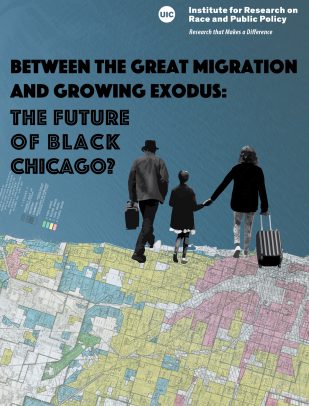UIC report examines black population loss in Chicago

The Great Migration of blacks to Chicago from the 1920s through the 1950s ushered in a major period of transformation for the city.
In contrast, the past three decades are far removed from that era as Chicago’s black population has dropped over 350,000 residents since its peak of almost 1.2 million in 1980.
The dramatic decline has led to an ongoing national storyline suggesting that black Chicagoans’ exodus from the city is being fueled by violence in their neighborhoods.
“This popular narrative overlooks the effects of government policies that are displacing black Chicagoans and how these dynamics are different from neighborhood to neighborhood,” said Amanda Lewis, director of the Institute for Research on Race and Public Policy and professor of African American studies and sociology at the University of Illinois at Chicago. “The more than 830,000 black Chicagoans still here make the city an important center of black life and culture in the United States and reinforces the urgency in ensuring that city policies are designed to address the needs of all neighborhoods and all Chicagoans.”
A mix of factors is involved and others aren’t well defined, but inequality stands out as a leading element, according to a new report co-authored by Lewis and researchers from the institute.
In “Between the Great Migration and Growing Exodus: The Future of Black Chicago?,” the demolition of public housing, the closing of Chicago Public Schools, the continuing effects of foreclosures and the housing crisis, health care and food deserts, high unemployment rates, and over-policing by local law enforcement are cited among the dynamics impacting where black Chicagoans live and why many are leaving the city.
The report’s key findings, which focus on data and analysis pertaining to three aspects of the city’s black population decline, include:
Chicago’s population trends over the last 100 years
- Chicago has welcomed an influx of black residents over 100 years when indicators of racial inequality, such as wage gaps or unemployment, were low in Chicago and in relation to other cities.
- Since the 1990s, levels of inequality have increased for black residents both within Chicago and in relation to other cities, which has corresponded with a significant loss of the black population over the last three decades.
Population trends by neighborhood
- Despite the racial composition of many neighborhoods in Chicago dramatically changing in the last three decades, black and white segregation remains extremely high.
- When comparing changes across race, the researchers find the neighborhoods that have had an increase in white population have generally had a decrease in black population, and vice versa.
Emigration routes from Chicago
- Contrary to narratives suggesting a “reverse migration” to the South, most blacks leaving Cook County remain anchored to the Chicago region and are relocating to surrounding counties such as Will, Grundy, Kendall, Kane and McHenry, or to Indiana in cities such as Hammond and Gary.
- When compared with white people moving out of Cook County, however, on average blacks are relocating to areas with lower educational attainment, higher unemployment, and lower earnings.
While disinvestment from black communities has received attention, the accounts of how predatory contract leasing and punitive fines and fees have affected the black community remains largely overlooked, contends Stacey Sutton, UIC assistant professor of urban planning and policy.
Black residents “are unjustly shouldering the economic burden of the punitive city,” wrote Sutton, who authored one of the report’s featured expert commentaries.
“Our goal in producing this report in collaboration with many area experts is that the information provided will inform more equitable policies to reverse the loss of Chicago’s black population and that doing so will improve the lives of all Chicagoans,” Lewis said.
In addition to Sutton’s contribution, the report also includes commentary from Teresa Córdova, director of the Great Cities Institute at UIC and professor of urban planning and policy; Eve L. Ewing, assistant professor in the School of Social Service Administration at the University of Chicago; Lisa Yun Lee, director of the National Public Housing Museum and UIC associate professor of art history and gender and women’s studies; Alden Loury, WBEZ senior editor in race, class and communities; Mary Pattillo, Harold Washington Professor of Sociology and African American Studies at Northwestern University; Barbara Ransby, director of the Social Justice Initiative at UIC, LAS distinguished professor, and UIC professor of history, African American studies, and gender and women’s studies; and David Stovall, UIC professor of African American studies and criminology, law, and justice.
Additional co-authors on the report are William “Buddy” Scarborough, assistant professor of sociology at the University of North Texas, and Iván Arenas, associate director for community partnerships in the institute.
Future public events will be held with community partners across Chicago to share this research and explore how this issue impacts all of its residents.
The report is the fourth installment in the Institute for Research on Race and Public Policy’s ongoing series that explores racial justice in Chicago. In June 2019, the institute released, “Adversity and Resiliency for Chicago’s First: The State of Racial Justice for American Indian Chicagoans,” which documents the historical and ongoing contributions of Native Americans in Chicago and examines how racial inequity impacts members of this community today. “A Tale of Diversity, Disparity, and Discrimination: The State of Racial Justice for Asian American Chicagoans,” which highlights major demographic changes in Chicago’s Asian-American community, was issued in April 2018. The series’ initial report, “A Tale of Three Cities: The State of Racial Justice in Chicago,” was published in 2017 and detailed the divergent conditions for blacks, Latinos and whites in the intersecting domains of housing, economics, education, justice and health.
